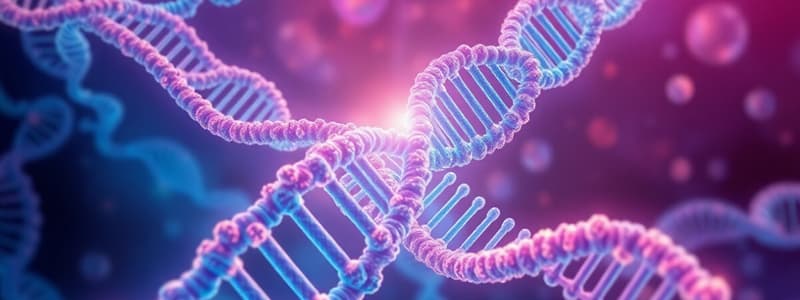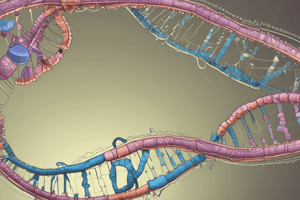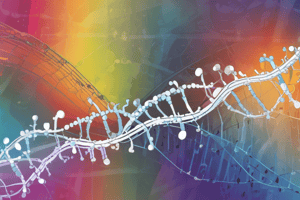Podcast
Questions and Answers
What is the first step in the transcription process?
What is the first step in the transcription process?
- RNA polymerase binds to the promoter sequence. (correct)
- The terminator sequence is reached.
- RNA is synthesized by complementary base pairing.
- DNA unwinds at the beginning of a gene.
Which strand of DNA is transcribed during transcription?
Which strand of DNA is transcribed during transcription?
- The coding strand
- The sense strand
- Both DNA strands
- The anti-sense strand (correct)
In what direction does transcription occur?
In what direction does transcription occur?
- 3' to 3'
- 3' to 5'
- 5' to 3' (correct)
- 5' to 5'
What happens when RNA polymerase reaches the terminator sequence?
What happens when RNA polymerase reaches the terminator sequence?
What does polycistronic mRNA mean?
What does polycistronic mRNA mean?
During the process of transcription, what occurs at the site of synthesis?
During the process of transcription, what occurs at the site of synthesis?
How does RNA polymerase synthesize RNA?
How does RNA polymerase synthesize RNA?
What is the role of the ribosomal binding site (RBS) in translation?
What is the role of the ribosomal binding site (RBS) in translation?
What is the primary outcome of gene expression alterations due to environmental influences?
What is the primary outcome of gene expression alterations due to environmental influences?
Which statement about transcription is correct?
Which statement about transcription is correct?
What is the role of messenger RNA (mRNA) in the process of translation?
What is the role of messenger RNA (mRNA) in the process of translation?
Which of the following best describes frameshift mutations?
Which of the following best describes frameshift mutations?
Which component is responsible for initiating transcription?
Which component is responsible for initiating transcription?
Which statement about the genetic code is accurate?
Which statement about the genetic code is accurate?
What is the significance of the start codon in protein synthesis?
What is the significance of the start codon in protein synthesis?
What type of mutation results from the deletion of a single nucleotide?
What type of mutation results from the deletion of a single nucleotide?
What is the primary role of messenger RNA (mRNA) in the protein synthesis process?
What is the primary role of messenger RNA (mRNA) in the protein synthesis process?
What is the definition of a mutation?
What is the definition of a mutation?
Which statement accurately contrasts DNA and RNA?
Which statement accurately contrasts DNA and RNA?
How do single-base addition or deletion mutations affect protein products compared to single-base substitutions?
How do single-base addition or deletion mutations affect protein products compared to single-base substitutions?
What distinguishes the stability of DNA from that of RNA?
What distinguishes the stability of DNA from that of RNA?
Where is ribosomal RNA (rRNA) primarily located?
Where is ribosomal RNA (rRNA) primarily located?
Why are most genes regulated at the level of transcription?
Why are most genes regulated at the level of transcription?
What is a downside of transcriptional regulation of gene expression?
What is a downside of transcriptional regulation of gene expression?
What type of RNA is primarily responsible for directing the synthesis of proteins?
What type of RNA is primarily responsible for directing the synthesis of proteins?
Which of the following statements about the location of RNA is true?
Which of the following statements about the location of RNA is true?
Which of the following statements about mutations is false?
Which of the following statements about mutations is false?
In terms of their structural composition, what is a key feature of RNA?
In terms of their structural composition, what is a key feature of RNA?
Which of the following is NOT a type of RNA involved in protein synthesis?
Which of the following is NOT a type of RNA involved in protein synthesis?
What role does transfer RNA (tRNA) play in protein synthesis?
What role does transfer RNA (tRNA) play in protein synthesis?
What is the first step in the process of transcription?
What is the first step in the process of transcription?
During which cellular process are amino acids linked to form proteins?
During which cellular process are amino acids linked to form proteins?
What modification occurs to mRNA after transcription in eukaryotes?
What modification occurs to mRNA after transcription in eukaryotes?
In what direction does transcription proceed?
In what direction does transcription proceed?
Which strand of DNA is used as the template during transcription?
Which strand of DNA is used as the template during transcription?
What is a codon?
What is a codon?
What happens when RNA polymerase reaches the terminator sequence?
What happens when RNA polymerase reaches the terminator sequence?
What type of RNA is produced during transcription?
What type of RNA is produced during transcription?
What is a key characteristic of introns?
What is a key characteristic of introns?
Why is the start codon 'AUG' crucial in translation?
Why is the start codon 'AUG' crucial in translation?
Which of the following statements about DNA and RNA is true?
Which of the following statements about DNA and RNA is true?
What does the redundancy of the genetic code mean?
What does the redundancy of the genetic code mean?
What is the primary role of translation in protein synthesis?
What is the primary role of translation in protein synthesis?
How many possible codons exist in the genetic code?
How many possible codons exist in the genetic code?
Which of the following statements regarding gene expression is incorrect?
Which of the following statements regarding gene expression is incorrect?
Flashcards
Gene
Gene
A DNA sequence copied into RNA, directing protein production.
Protein
Protein
Key determinants of an individual's traits, often enzymes.
Transcription
Transcription
The process of copying DNA into RNA.
RNA
RNA
Signup and view all the flashcards
mRNA
mRNA
Signup and view all the flashcards
rRNA
rRNA
Signup and view all the flashcards
DNA vs. RNA
DNA vs. RNA
Signup and view all the flashcards
Nucleic acid
Nucleic acid
Signup and view all the flashcards
tRNA function
tRNA function
Signup and view all the flashcards
mRNA codon
mRNA codon
Signup and view all the flashcards
Transcription location
Transcription location
Signup and view all the flashcards
RNA polymerase
RNA polymerase
Signup and view all the flashcards
Transcription direction
Transcription direction
Signup and view all the flashcards
Transcription start
Transcription start
Signup and view all the flashcards
Translation location
Translation location
Signup and view all the flashcards
Codon
Codon
Signup and view all the flashcards
Protein Synthesis (Translation)
Protein Synthesis (Translation)
Signup and view all the flashcards
Ribosomal Binding Site (RBS)
Ribosomal Binding Site (RBS)
Signup and view all the flashcards
Initial Peptide Bond
Initial Peptide Bond
Signup and view all the flashcards
Chain Elongation
Chain Elongation
Signup and view all the flashcards
Chain Termination
Chain Termination
Signup and view all the flashcards
Transcription (Prokaryotes)
Transcription (Prokaryotes)
Signup and view all the flashcards
mRNA (in Transcription)
mRNA (in Transcription)
Signup and view all the flashcards
Transcription Steps
Transcription Steps
Signup and view all the flashcards
Transcription
Transcription
Signup and view all the flashcards
Translation
Translation
Signup and view all the flashcards
Codon
Codon
Signup and view all the flashcards
Genetic Code
Genetic Code
Signup and view all the flashcards
Transcription location
Transcription location
Signup and view all the flashcards
Translation location
Translation location
Signup and view all the flashcards
Polypeptide
Polypeptide
Signup and view all the flashcards
Frameshift mutation
Frameshift mutation
Signup and view all the flashcards
RNA vs. DNA
RNA vs. DNA
Signup and view all the flashcards
Transcription product
Transcription product
Signup and view all the flashcards
Translation product
Translation product
Signup and view all the flashcards
Genetic code redundancy
Genetic code redundancy
Signup and view all the flashcards
Start Codon
Start Codon
Signup and view all the flashcards
Introns in Genes
Introns in Genes
Signup and view all the flashcards
Translation of mRNA
Translation of mRNA
Signup and view all the flashcards
Transcription direction
Transcription direction
Signup and view all the flashcards
Mutation effect
Mutation effect
Signup and view all the flashcards
Frameshift mutation
Frameshift mutation
Signup and view all the flashcards
Transcriptional Regulation
Transcriptional Regulation
Signup and view all the flashcards
Post-transcriptional Control
Post-transcriptional Control
Signup and view all the flashcards
Single-base addition/deletion
Single-base addition/deletion
Signup and view all the flashcards
Study Notes
Overview of Chapter 12
- The chapter focuses on the process of converting genetic information into proteins.
- This process involves two main stages: transcription and translation.
- RNA plays a crucial role in both stages, acting as an intermediary between DNA and proteins.
Transcription
- Synthesis of a complementary mRNA strand from a DNA template.
- Begins when RNA polymerase binds to a promoter sequence on DNA.
- Proceeds in the 5' to 3' direction (anti-sense strand).
- Stops when RNA polymerase reaches the terminator sequence on DNA.
- Occurs in the nucleus.
- RNA polymerase synthesizes RNA using one strand of DNA as a template.
RNA Structure
- RNA is a polymer of nucleotides, like DNA.
- RNA is single-stranded.
- RNA uses ribose sugar instead of deoxyribose.
- RNA uses uracil (U) instead of thymine (T).
RNA Types and Functions
- mRNA (messenger RNA): Specifies the order of amino acids in a protein.
- rRNA (ribosomal RNA): Main component of ribosomes; assists in making covalent bonds between amino acids.
- tRNA (transfer RNA): Transports the correct amino acid to the ribosome.
Translation
- Converting a sequence of bases in mRNA to a sequence of amino acids in a protein.
- Occurs at the ribosomes, which are made up of proteins and rRNA.
- Codons of mRNA are "read" sequentially.
- tRNA molecules transport the required amino acids to the ribosome.
- tRNA molecules have an anticodon that pairs with the codon.
- Amino acids are joined by peptide bonds.
Key Points from the Chapters
- Translation of mRNA starts at a sequence called the Shine-Dalgarno sequence.
- Translation ends at nonsense codons: UAA, UAG, or UGA.
- 61 sense codons code for the 20 amino acids.
- The genetic code is highly specific.
- The genetic code is unambiguous, meaning each codon specifies only one amino acid.
- The genetic code is redundant, meaning multiple codons can specify the same amino acid.
- The genetic code is virtually universal.
- In eukaryotes, mRNA is chemically modified after transcription.
Additional Details/Concepts
- Transcription in prokaryotes
- mRNA can be polycistronic
- Post-transcriptional processing
- Modifies mRNA, RNA splicing.
- Mutations
- Changes in the base sequence of DNA.
- Single base addition or deletion is likely to alter the protein product more than a single-base substitution.
- Genetic Code redundancy and the number of codons.
- Environmental influences on gene expression can alter gene expression and lead to abnormalities, such as cyclopia.
- RNA-only genes exist to make RNA other than mRNA and have specific functions other than coding proteins.
Studying That Suits You
Use AI to generate personalized quizzes and flashcards to suit your learning preferences.
Related Documents
Description
This chapter covers the complex process of protein synthesis, focusing on the stages of transcription and translation. Learn about the crucial role of RNA and its various types in converting genetic information into functional proteins. Discover how RNA is synthesized from DNA and its structural differences from DNA.




